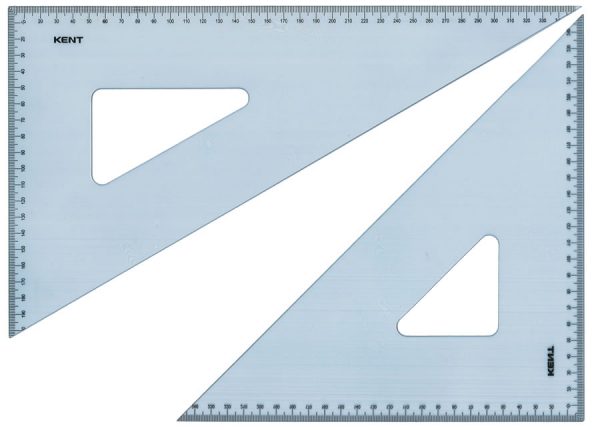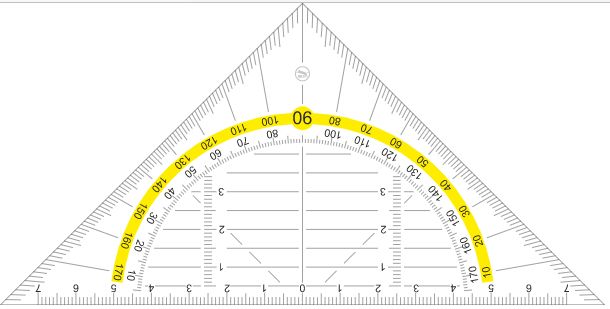
三角尺的商品名稱是 set square 或 triangle。

附量角器的三角板,稱為 Geodreieck。


附量角器的三角板,稱為 Geodreieck。
我們從多面體的稜觀察到線段:line segment 或直接說 segment, 它們的端點稱為 endpoints; 朝向一側無限延伸稱為射線 (ray),朝兩側無限延伸就是直線 (straight line 或 line)。 線段的中點 (midpoint) 平分 (bisects) 這條線段, 而中垂線 (perpendicular bisector) 上的點與線段兩端點等距 (equidistant); 反之 (conversely),與線段兩端點等距的點在中垂線上: If a point is equidistant from the endpoints of a line segment, then it is on the perpendicular bisector of the segment.
所謂三角尺或三角板稱為 set square 或者就說 triangle,關鍵是它提供了直角, 因此可以輕易畫一條直線的垂線 (a perpendicular to a given line), 也可以過指定的點作垂線 (the perpendicular through a given point), 不論是過線上一點,還是過線外一點,都可以作垂線:
the perpendicular at a point on the line過直線 L 外一點 P 的垂線與 L 的交點 (point of intersection 或者就說 intersection), 稱為點 P 到直線 L 的垂足:The foot of the perpendicular from P to L, 或者直接說 the foot of P on L。 有些高中老師習慣稱垂足為正射影:the orthogonal projection of P on L。
the perpendicular from a point off the line / not on the line
Perpendicular 既是形容詞也是名詞。 垂直性 (perpendicularity) 是互相的 (symmetric), 它是直線、射線、線段、平面之間的關係。 但是垂直的前提是相交 (intersect),延長之後才垂直的線段就不稱為垂直。 垂直 (perpendicular) 跟正交 (orthogonal) 幾乎是同義詞, 對比較具體的幾何物件說 perpendicular,對比較抽象的說 orthogonal。
共平面的 (coplanar) 不相交直線稱為平行線: Parallel lines are coplanar straight lines that do not intersect。 所以當我們說「L、M 為空間中的平行線」就已經寓意 L 和 M 在同一張平面上。 不共面的直線稱為歪斜線: Noncoplanar lines are called skew lines。
因為平行線有公垂線 (common perpendiculars), 所以使用三角板也可以輕易作一條直線的平行線:Constructing parallel lines to a given line, 或者在指定點上作平行線:Constructing the parallel through a given point。
Parallel 既是形容詞也是名詞。 平行性 (parallelism) 也是互相的,它是直線、平面之間的關係。
德國有一種附量角器的三角板,稱為 Geodreieck,如下圖。
| [語音講解:line.mp3] |